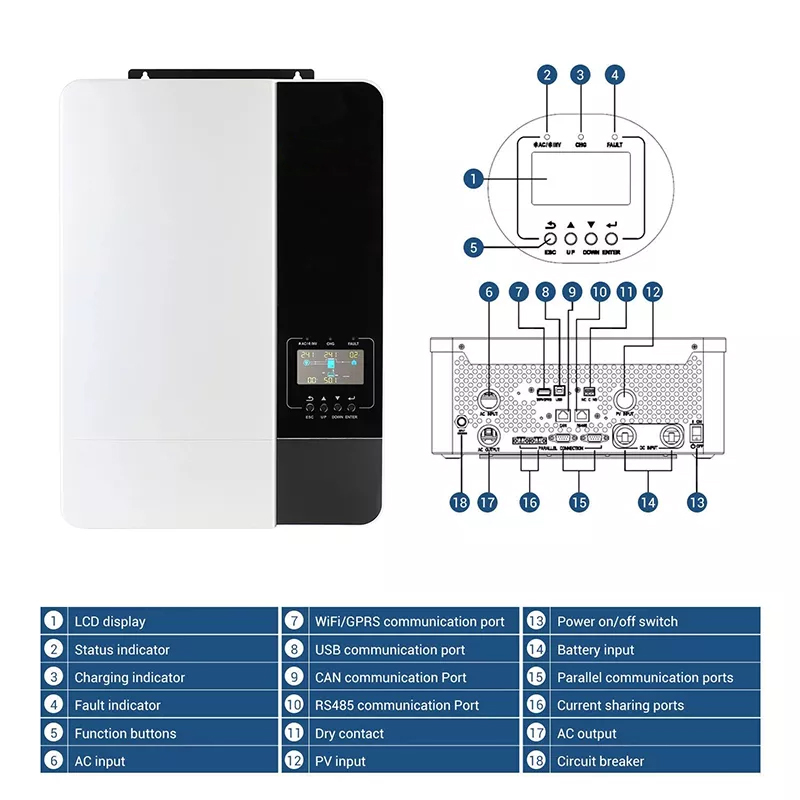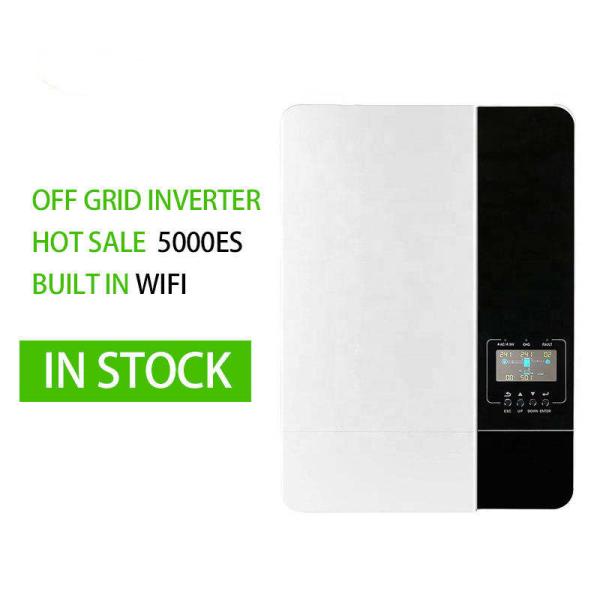| Sign In | Join Free | My esadidasol.com |
|
| Sign In | Join Free | My esadidasol.com |
|
| Categories | Hybrid Solar Inverter |
|---|---|
| Brand Name: | KVOU |
| Model Number: | SPF 5000 ES |
| Certification: | CE,UL |
| Place of Origin: | China |
| MOQ: | 1 |
| Price: | Negotiable |
| Payment Terms: | T/T, D/P, D/A |
| Supply Ability: | 5000 unit per month |
| Delivery Time: | 7-15working days |
| Packaging Details: | Wooden case and Carton case |
| Output Frequency: | 50Hz,60Hz |
| Size: | 485/330/135mm |
| Inverter Efficiency: | 98.3% |
| Battery Voltage: | 48VDC |
| Parallel Capability: | 6 Units Maximum |
| AC input voltage: | 230V |
| Output Current: | 80A |
| Display: | LCD Display |
All-in-one Inverter Built in 5KW 48V Pure Sine Wave Inverter Controller
Describe
5KW is a multifunctional inverter/charger that combines the functions of an inverter, solar charger and battery charger to provide UPS support in a portable size. Its comprehensive LCD display provides user-configurable and easy-to-access button operations such as battery charging current, AC/solar charger priority, and acceptable input voltage based on different applications.
feature:
Pure Sine Wave Solar Inverter
Output power factor 1
Built-in 80A MPPT solar charger
Built-in dustproof kit for harsh environments
Optional: Support up to 3 parallel operation (applicable to
3KW-5.5KW 48V)
WIFI remote monitoring (optional)
compatible generator

FQA:
1.What should I do if the inverter battery is out of water?
What happens if the lead-acid battery runs out of water? If this
happens, the lead plates will be exposed to the oxygen and hydrogen
gas present in the battery. This exposure causes an exothermic
reaction at the battery terminals that emits a large amount of
heat. The heat causes the water to evaporate further.
2.What destroys an inverter battery?
Letting the charge in the battery drain completely before
recharging it frequently can damage the batteries in the inverter
battery. This shortens its service life.
3.What to Know Before Buying an Inverter Battery?
A 3-step guide to choosing the right inverter and inverter battery
Step 1: Determine your power requirements. Don't get confused by
the word "identify". ...
Step 2: Check the VA rating of the inverter. ...
VA = power requirement/power factor. ...
Step 3: Get the right battery for your inverter.
4.Are bigger inverters better?
With an extra large array, you'll make better use of the inverter's
capacity, producing more overall power. You want to find the "sweet
spot" where you can get the most overall output per dollar spent on
the system -- even if it means cutting more power.

|